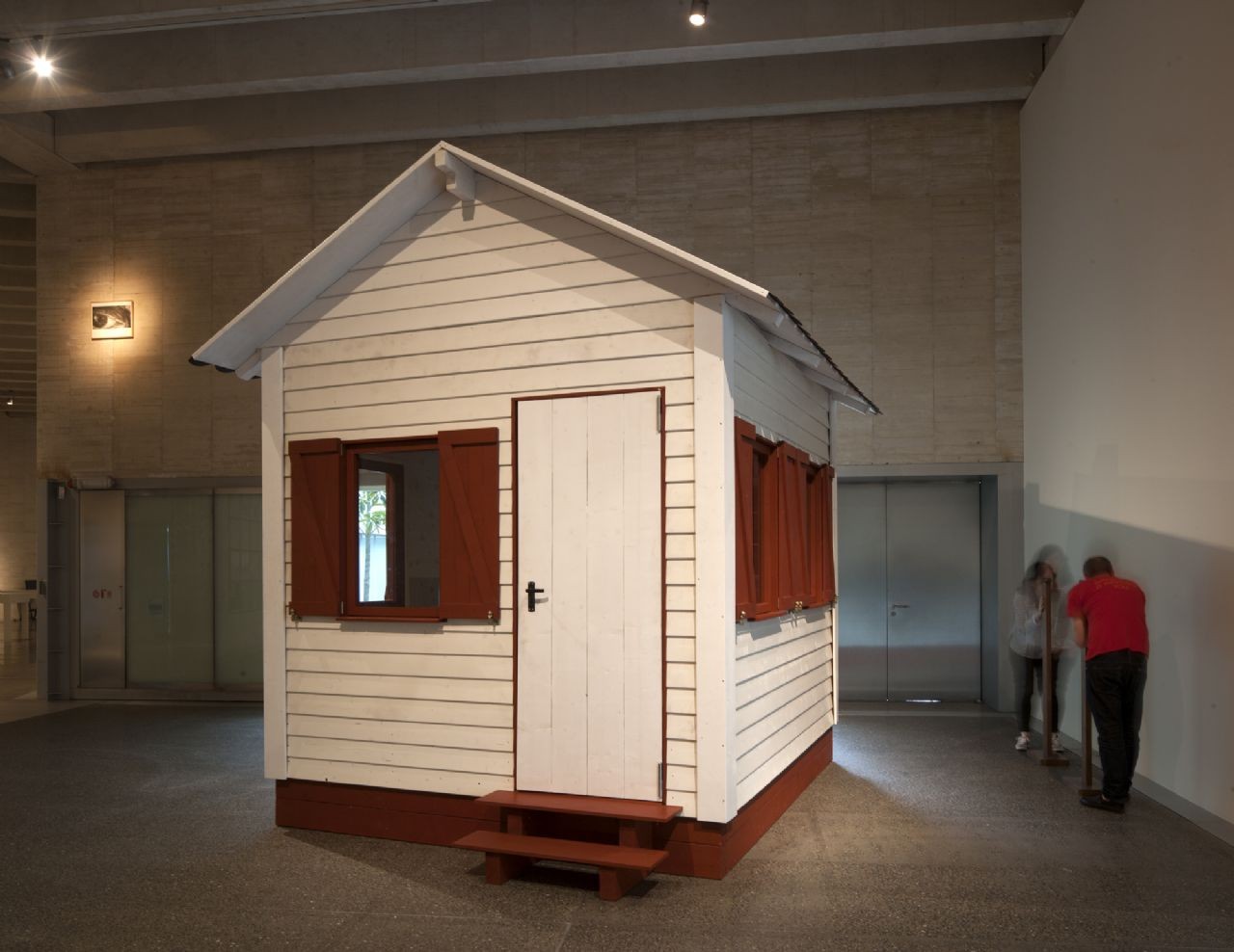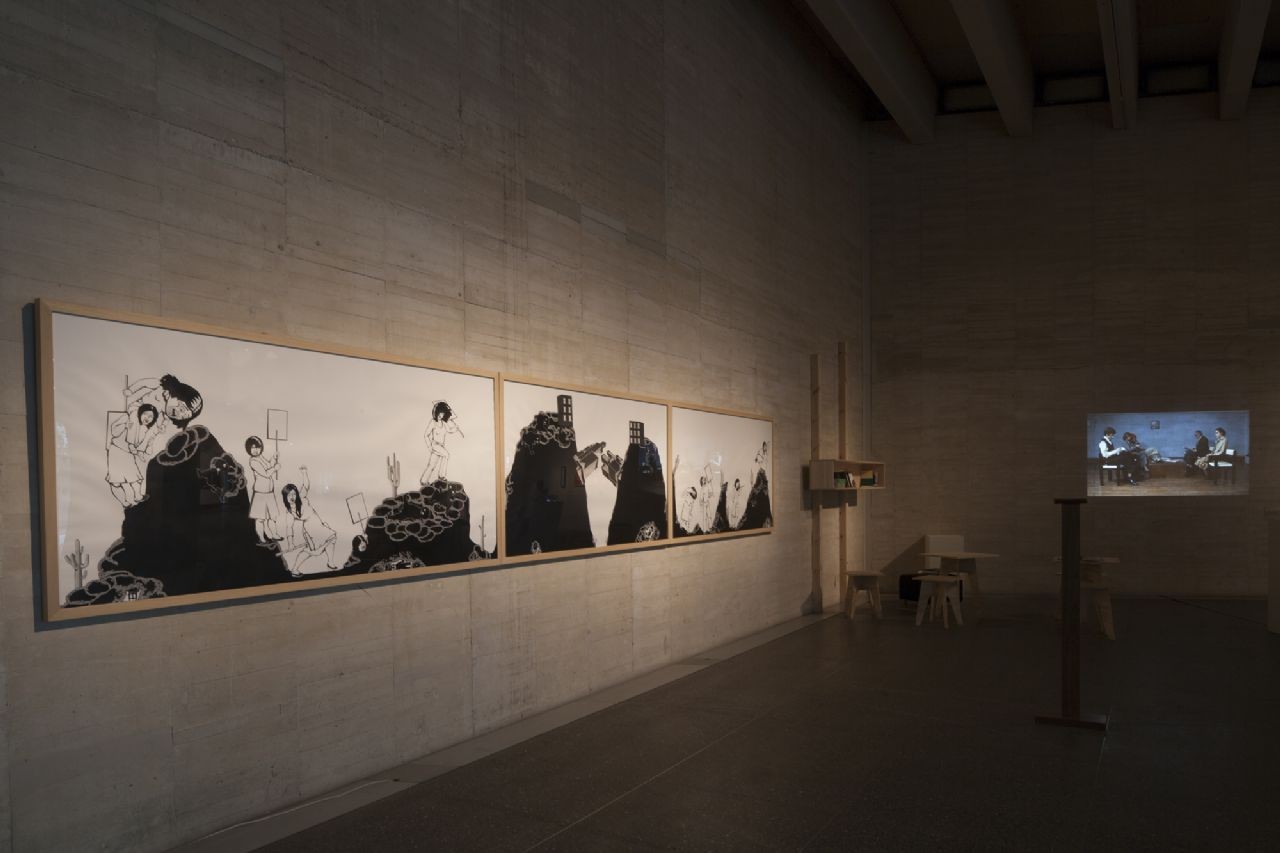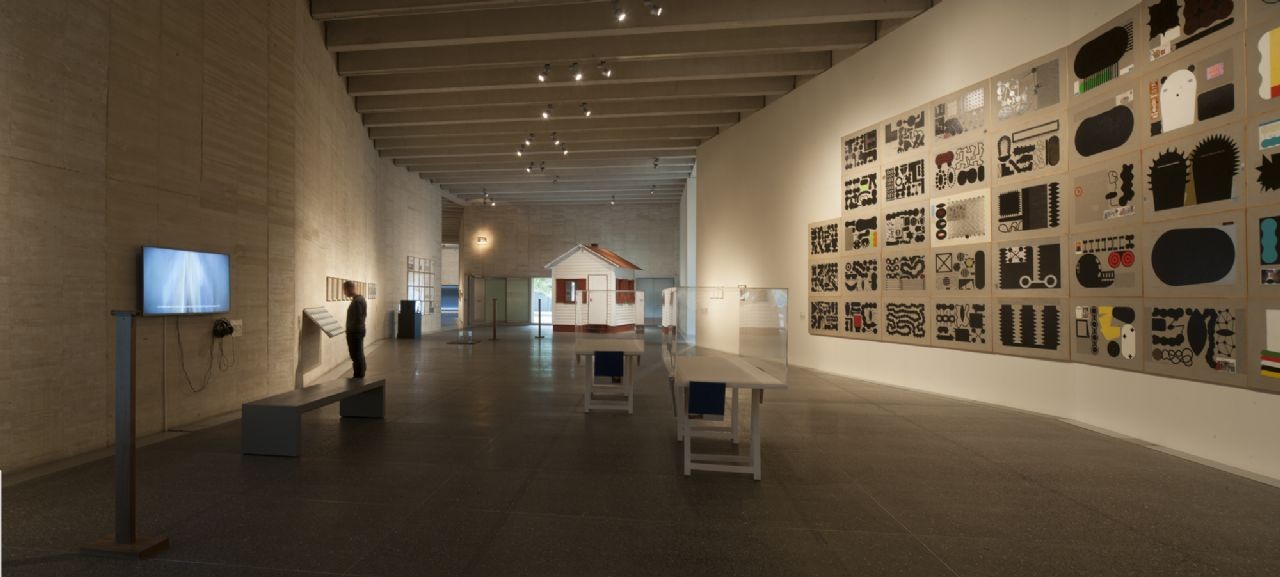A Perfect Vacuum
A Reading on MUSAC Collection
20 May - 03 Sep 2017

Jimmie Durham. Nature Morte with Stone and House, 2007, Exhibition View in A Perfect Vacuum. A Reading on the MUSAC Collection at MUSAC, 2017

Diego del Pozo. Cuatro amantes cuatro inversiones, 2003. Exhibition View in A Perfect Vacuum. A Reading on the MUSAC Collection at MUSAC, 2017

Diego del Pozo. Cuatro amantes cuatro inversiones, 2003. Exhibition View in A Perfect Vacuum. A Reading on the MUSAC Collection at MUSAC, 2017

Diego del Pozo. Cuatro amantes cuatro inversiones, 2003. Exhibition View in A Perfect Vacuum. A Reading on the MUSAC Collection at MUSAC, 2017

Jimmie Durham. Nature Morte with Stone and House, 2007, Exhibition View in A Perfect Vacuum. A Reading on the MUSAC Collection at MUSAC, 2017
A PERFECT VACUUM
A Reading on MUSAC Collection
20 May - 3 September 2017
Curator: Eduardo García Nieto
Coordinator: Koré Escobar
Coordination assitant: Carlos González
It is interesting to note that the two periods of most intense research in the literary genre known as science fiction coincide with cycles of changes in production processes, the advent of the Industrial Revolution and the third quarter of the last century. If we were to analyse and propose an "archaeology of the future" of these creative moments, the digression would need to be much longer, so we will focus on only oneroom, understanding this as an institution or as a shelf: the library.
“Among these books I noted masterpieces by the greats of ancient and modern times, in other words, all of humanity"s finest achievements in history, poetry, fiction, and science, from Homer to Victor Hugo, from Xenophon to Michelet, from Rabelais to Madame George Sand.”
Jules VERNE; Twenty Thousand Leagues Under the Sea, 1869
When Captain Nemo equipped the Nautilus he built inside a library containing the whole literary production published up to the moment in which he sails with his ship. From that moment the submarine library stops growing, it remains immovable at a notion of culture that isremote from all the changes and all possible new organizations and classifications.
“A tale of what is desired but is not to be had.”
Stanislaw LEM, Perfect Vacuum. Library of the 21st Century, 1971
Now, let us think of the Library of the 21st Century that Stanislaw Lem offers us, which starts with Perfect Vacuum. In contrast withVerne’s encyclopaedic vision, this library of what is to come has only around thirty titles and, since they are works that won’t be published until the century following that in which the author wrote them, they have one thing in common: they only exist as book reviews or as forewords, which allows Lem to "announce sins that he is not going to commit".
In this way, unlike the populated underwater stillness that heralds a suspension in culture, Lem offers a library of nothingness, of unwritten, unpublished works that nonetheless contain the knowledge and concerns that the author, with high doses of humour, presents us as a possible culture to come.
“Effective democratization can always be measured by this essential criterion: the participation in and the access to the archive, its constitution, and its interpretation.”
Jacques DERRIDA, Archive Fever, 1995
It is not by mere chance that we have focused on the library to establish a dialogue or reinterpretation of the MUSAC’s collection. A unifying element that we find in the library and in the archive and the museum is the fact that, in their alleged neutrality,they are power devices, hence the Derridian concern for the democratization of the archive. What is preserved, how do we catalogue or what are the dissemination methods are not just mechanical or objectives operations. When faced with all these actions a question is raised: What is our relationship with culture as individuals?
With that in mind, this exhibition departs from a ground of possibility — how did Lem imagine 21st century culture at the end of the 20th century—, and a correlation of events —Perfect Vacuum was published in 1971, the year of production of the oldest pieces in the MUSAC’s collection.
The works of the collection selected for the exhibition do not seek to "illustrate" Lem’s texts, since art is never illustrative, but to open lines of discourse that everyone can identify, or create, based on tags or terms taken from the Library of the 21st Century which are available in the room’s notebook.
These include concepts such as chronology, future, society, consumption, sex, prognosis, nostalgia, story, cosmosis... appearing repeatedly in all the writings that make up this hypothetical library and that, ultimately, do nothing but force us to rethink our role as transforming agents, on a micro or macro scale, of society. Maybe our boldness lies, though,in the imagination of other scenarios that can generate other possibilities for the future, fictions that are distant from a self-imposed reality in which technological changes are adopted with anacritical casual, everyday attitude that has turned the future into a continuous and immediate present.
A so-called Emotional Library has been also built within the exhibition space. Our aim with it is to work on other possible nodes of connection and ways of increasing our experiences with culture.
Emotional Library
(Possible) User Instructions
. Think of a book that is important for you.
. Remember your experiences and the things you learnt with that book.
. Make a mental note of the other readings this book guided you to.
. Imagine sharing it.
. Do you find the idea uncomfortable?
. Do you prefer to write only the title and author in the desiderata list so that the library acquires it or would you like to donate the book, feel the weight of the paper and the abandonment after doing so?
. Does the donated copy have some lines jotted down and underlined by you?
. Do you want to leave a message to others or is the book itself already a message?
. Are you curious about the books other people left in the library?
.Would you like to know the reasons why they chose that title and not another?
. Rewrite these instructions to your liking or simply describe how you think this library should be expanded, organized and enjoyed.
A Reading on MUSAC Collection
20 May - 3 September 2017
Curator: Eduardo García Nieto
Coordinator: Koré Escobar
Coordination assitant: Carlos González
It is interesting to note that the two periods of most intense research in the literary genre known as science fiction coincide with cycles of changes in production processes, the advent of the Industrial Revolution and the third quarter of the last century. If we were to analyse and propose an "archaeology of the future" of these creative moments, the digression would need to be much longer, so we will focus on only oneroom, understanding this as an institution or as a shelf: the library.
“Among these books I noted masterpieces by the greats of ancient and modern times, in other words, all of humanity"s finest achievements in history, poetry, fiction, and science, from Homer to Victor Hugo, from Xenophon to Michelet, from Rabelais to Madame George Sand.”
Jules VERNE; Twenty Thousand Leagues Under the Sea, 1869
When Captain Nemo equipped the Nautilus he built inside a library containing the whole literary production published up to the moment in which he sails with his ship. From that moment the submarine library stops growing, it remains immovable at a notion of culture that isremote from all the changes and all possible new organizations and classifications.
“A tale of what is desired but is not to be had.”
Stanislaw LEM, Perfect Vacuum. Library of the 21st Century, 1971
Now, let us think of the Library of the 21st Century that Stanislaw Lem offers us, which starts with Perfect Vacuum. In contrast withVerne’s encyclopaedic vision, this library of what is to come has only around thirty titles and, since they are works that won’t be published until the century following that in which the author wrote them, they have one thing in common: they only exist as book reviews or as forewords, which allows Lem to "announce sins that he is not going to commit".
In this way, unlike the populated underwater stillness that heralds a suspension in culture, Lem offers a library of nothingness, of unwritten, unpublished works that nonetheless contain the knowledge and concerns that the author, with high doses of humour, presents us as a possible culture to come.
“Effective democratization can always be measured by this essential criterion: the participation in and the access to the archive, its constitution, and its interpretation.”
Jacques DERRIDA, Archive Fever, 1995
It is not by mere chance that we have focused on the library to establish a dialogue or reinterpretation of the MUSAC’s collection. A unifying element that we find in the library and in the archive and the museum is the fact that, in their alleged neutrality,they are power devices, hence the Derridian concern for the democratization of the archive. What is preserved, how do we catalogue or what are the dissemination methods are not just mechanical or objectives operations. When faced with all these actions a question is raised: What is our relationship with culture as individuals?
With that in mind, this exhibition departs from a ground of possibility — how did Lem imagine 21st century culture at the end of the 20th century—, and a correlation of events —Perfect Vacuum was published in 1971, the year of production of the oldest pieces in the MUSAC’s collection.
The works of the collection selected for the exhibition do not seek to "illustrate" Lem’s texts, since art is never illustrative, but to open lines of discourse that everyone can identify, or create, based on tags or terms taken from the Library of the 21st Century which are available in the room’s notebook.
These include concepts such as chronology, future, society, consumption, sex, prognosis, nostalgia, story, cosmosis... appearing repeatedly in all the writings that make up this hypothetical library and that, ultimately, do nothing but force us to rethink our role as transforming agents, on a micro or macro scale, of society. Maybe our boldness lies, though,in the imagination of other scenarios that can generate other possibilities for the future, fictions that are distant from a self-imposed reality in which technological changes are adopted with anacritical casual, everyday attitude that has turned the future into a continuous and immediate present.
A so-called Emotional Library has been also built within the exhibition space. Our aim with it is to work on other possible nodes of connection and ways of increasing our experiences with culture.
Emotional Library
(Possible) User Instructions
. Think of a book that is important for you.
. Remember your experiences and the things you learnt with that book.
. Make a mental note of the other readings this book guided you to.
. Imagine sharing it.
. Do you find the idea uncomfortable?
. Do you prefer to write only the title and author in the desiderata list so that the library acquires it or would you like to donate the book, feel the weight of the paper and the abandonment after doing so?
. Does the donated copy have some lines jotted down and underlined by you?
. Do you want to leave a message to others or is the book itself already a message?
. Are you curious about the books other people left in the library?
.Would you like to know the reasons why they chose that title and not another?
. Rewrite these instructions to your liking or simply describe how you think this library should be expanded, organized and enjoyed.



